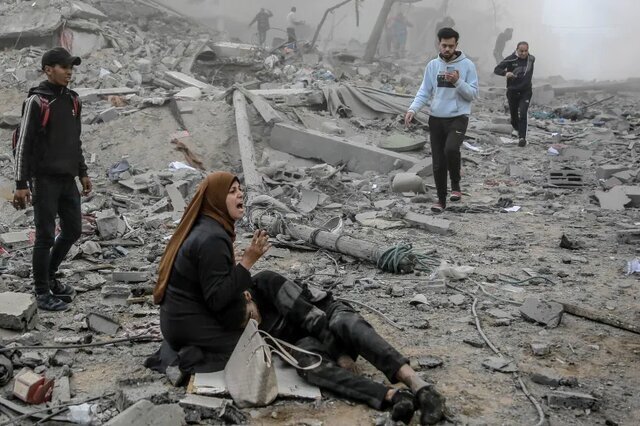Why Tel Aviv violated the Gaza ceasefire; Intensifying the political crisis in the occupied territories.
While less than three months have passed since the ceasefire between the Zionist regime and Hamas was established, and in the first phase, prisoners from both sides were released several times, Tel Aviv has refused to implement the second phase of the ceasefire, and thus we are witnessing ceasefire violations and renewed escalation of Zionist attacks on the northern, central, and southern regions of the Gaza Strip.
The Zionist regime is not ready to end the war
The ceasefire agreement between the Zionist regime and Hamas was signed in the last days of the Biden administration, and its first phase was also implemented with the release of prisoners between the two sides. However, on the sixteenth day of the ceasefire, the two sides were supposed to enter into negotiations on a permanent end to the war. However, the regime not only failed the ceasefire agreement by making demands that went beyond the agreement, such as the release of more prisoners by Hamas and the refusal to implement the second phase of the agreement, which is the beginning of the withdrawal from Gaza, but it has also launched renewed air and ground attacks on Gaza.
In this context, many analysts and former officials of the regime believe that the Zionist leaders have deliberately violated the ceasefire agreement. It seems that Tel Aviv is not interested in ending the Gaza war because the negotiations for the second phase of this agreement will ultimately lead to an end to the war and the release of all 59 Zionist prisoners who are still being held in Gaza. This is while the objective result of these actions of the occupation regime is endangering the lives of the prisoners. The Association of Families of Prisoners in the Occupied Territories also announced in a statement: “Our greatest fear has come true and we are afraid of a deliberate disruption in the process of returning the prisoners.”
US support is the main reason for violating the ceasefire
The most important factor that has led the Zionist regime to violate the ceasefire is the approach of the US government. While Trump claimed to support the ceasefire agreement in Gaza at the beginning of this year, he is now supporting the renewed attacks of the Zionist regime. Haaretz expert Amos Harel believes that “Israel knowingly violated the ceasefire agreement with Hamas – with the approval of the United States – because it did not want to fully comply with the conditions it had committed to two months ago.” The objective evidence also confirms the decisive role of the United States in violating the agreement.
1. Trump initially lifted the suspension of the delivery of 2,000-pound bombs to Tel Aviv, and then it was decided that 1,800 MK-84 bombs would be delivered to the regime. In fact, by handing over these bombs, Trump has effectively allowed the regime to target densely populated areas in Gaza and cause widespread human casualties.
2. Trump then claimed to have a Middle East peace plan by proposing to transfer more than a million people from Gaza to Jordan and Egypt. He said in this regard: “You are talking about 1.5 million people and we are just cleaning everything up.” In a meeting with the King of Jordan, he asked the country to accept more Palestinian citizens. Trump also claimed in an interview: “Gaza has had a lot of conflict over the centuries and I don’t know, something has to happen; it’s literally a place of destruction, everything is destroyed and people are dying there, so I would rather engage with some of the Arab countries and build housing somewhere else where they can maybe live in peace.”
3. Finally, the US foreign policy agenda before the start of the second phase of the ceasefire between the parties shifted to issues beyond the text of the agreement. This is because Steve Whittaker, Trump’s Middle East envoy, ignored the previous agreement and proposed a new ceasefire terms and demanded the release of more Zionist prisoners before the start of the end-of-war negotiations.
It can be said that after accepting the ceasefire agreement, which was considered a kind of victory for Hamas, and especially with the implementation of the second phase, Tel Aviv’s withdrawal from the Philadelphia and Netzarim axes would be fully realized, the new US administration stepped in to support its ally and put forward new conditions.
The occupying regime, while pressuring Hamas to agree to these conditions, has also returned to the war by violating the ceasefire. The US is the most important supporter of the occupying regime and provides the most weapons to this regime, and at the same time, it is the only country that has real leverage against this regime. Therefore, as long as the US violates its commitments to support the ceasefire and maintain international peace and security, there can be no end to the war, especially where the real and field commitments of the occupiers are involved.
Internal Crises of the Zionist Regime
Starting a new war or evading commitments is always one of the tools that actors face when faced with internal crises. Although the beginning of the Al-Aqsa Storm and the hard blow from Hamas caused the Zionists to suspend their internal conflicts and create a united military front against Hamas, conflict and crisis are now the main characteristics of the internal politics of the Zionist Regime.

